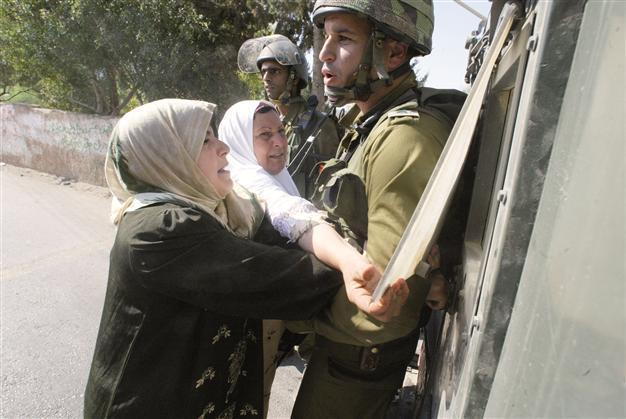Films shed light on life under occupation in Palestine
Emrah Güler

While many are learning about the horrors in the region through social media, films on Palestine depict life under occupation through human stories.
Children throwing bricks at military vehicles, climbing walls to see loved ones and teaching children martyrdom as the most honorable status are some of the scenes in a string of documentaries and one feature shedding light on life in Palestine under occupation. While many are getting around to the horrors in the region through social media, these films will show life under occupation through human stories.“In early 2001 I spent three months in Gaza filming material for this documentary, ‘Gaza Strip,’” writes filmmaker James Longley on his website daylightfactory.com, where he has introduced his 2002 feature documentary available for free online streaming. “The second Palestinian uprising against Israeli military occupation had begun in September 2000, and there had already been large numbers of deaths in Gaza when I started this project.”
“The time since the release of this film in 2002 has seen many changes,” he also writes in the introduction, dated 2011. The film follows 13-year-old Palestinian Mohammed and his friends, a group of angry, poverty-stricken children who get their only kicks out of throwing stones and bricks at the Israeli tanks, who don’t always retaliate in a similar manner. The backdrop is the Second Intifada, and there are no signs of Israelis in the film save from the military vehicles and the familiar flag.
“Gaza Strip” sets out to tell the story of a historically troubled region through the voices of the oppressed, violated and tyrannized, through the voices of Palestinians having to live everyday with death at their side. Many across the world, thanks to social media, might just be getting to know the horrors of the region, with stories and pictures of civilians and children wounded and worse. “Gaza Strip,” more than a decade ago, had documented the atrocities against the children of Gaza, albeit mostly to those who already knew.
Death in Gaza, on film and in reality
“Death in Gaza” is another documentary of a decade back, another one getting too close to the heart of the conflict and those affected the most from the conflict. In fact too close, as the film’s producer and director James Miller was killed in 2003 by a soldier from the Israeli Defense Forces while filming the documentary. In all likelihood, “Death in Gaza” is not the film Miller had intended it to be, with his chances to film the Israelis cut off prematurely.
Yet, with Miller’s death added to the narrative, and “death” in the title of the film acquiring a whole new meaning, “Death in Gaza” continues to resonate to date. The film takes on a journey from the West Bank to Gaza and Rafah refugee camp, telling the horrors of the region and dissecting the makings of a broken society by following children in their early teens. Children throwing stones, as well as homemade explosives, at the military vehicles are familiar pictures here as well.
However, Miller goes further to explore the deep-rooted sense of martyrdom and hate toward the enemy as they are constructed among the Palestinian children in the region, as the seeds of potential suicide bombers are grown. “Death in Gaza” is as bleak and dark as it should get, perhaps a tad too much, occasionally forgetting to portray the bigger picture in the interests of capturing gruesome details. The film was, perhaps, the closest mainstream culture would get to the reality of Gaza (before the age of social media), going on to win three Primetime Emmys upon its airing on HBO in 2004.
Love and life under occupation
A decade later, we get a glimpse into how the children of “Gaza Strip” and “Death in Gaza” would turn into (if they have defied death) in Palestinian director and writer Hany Abu-Assad’s 2013 feature, “Omar,” which was among last year’s Oscar nominees for Best Foreign Language Film. Abu-Assad’s previous feature, “Paradise Now,” was the first film from Palestine to be nominated for an Oscar in 2006. “Omar” is not a documentary, yet the sense of urgency and the realistic look at the everyday life in Palestine under occupation is similar to the two other documentaries.
The film is a thriller and romance, where the leading character in the title (played by Adam Bakri) leads a dangerous life, both for love and freedom. Omar has to climb high walls separating the Palestinian neighborhoods to see the object of his affection, Nadia (Leem Lubany), and he also has to meet with Nadia’s brother Tarek (Iyad Hoorani) to plan an attack against the Israeli forces. “Omar” is a political thriller where a sense of paranoia, fuelled by the impact of the occupation on the everyday lives, is the defining characteristic of the movie.
Another notable film on the Israel-Palestine conflict is 2011’s “5 Broken Cameras,” a documentary co-directed by the self-taught Palestinian cameraman and director Emad Burnat, and the Israeli director Guy Davidi. The film started out as a compilation of footage of protests in Bil’in, a West Bank village affected by the Israeli West Bank barrier, by Burnat, and was completed with Davidi.
“5 Broken Cameras” was nominated for the Best Documentary Feature Oscar in 2013, sparking controversy as to whether the film was a Palestinian or an Israeli production. Davidi, however, said the film was “first and foremost... a Palestinian film,” adding, “I don’t think films should have citizenships.”
These films should serve to complete (and cement, in some cases) the stories and photos shared in social media in the wake of another war in Gaza.
















